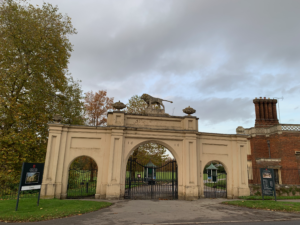Saturday 12 May 2023
Guidebook: 18.4 miles
Iphone: 49,576 steps
Before embarking on day three of my Walsingham Camino, I spend Friday night at the Lee Valley Youth Hostel near Cheshunt. My room is a quiet and comfortable, if minimalist, en-suite twin – very different from the bunk-bedded dormitories I associate with the YHA from my student days. A short evening stroll beside the River Lee Navigation brings me back to the same boats, same towpath as before, although the riverside vegetation has grown tall and lush in the few weeks since I was here.
Breakfast next morning is a tasty full English, served cafeteria-style in a dining hall buzzing with dozens of teenagers on a school excursion. Then it’s into the car, and a short drive to Stanstead St Margaret where I left off my walk last time.
It’s mid-May, and although the day is cool and overcast you can almost watch the plants grow and the leaves expand on the trees. Lacy cow parsley lines the river bank, mingling with purple bell-flowered comfrey. The geese have cute, fluffy goslings now, and I’m accompanied by a constant soundtrack of exuberant birdsong. I’ve forgotten to pack my rosary beads, so I pray my first decades of the day counting on my fingers, reflecting that May is called Mary’s month. I love this season of new life and summer’s promise. Maybe, just maybe, the sun might come out later.

The Hertfordshire Way
The guidebook* takes me on a little detour across the railway line and up to the New River where I see one bold little duckling venturing some distance from his mother and siblings. A footbridge takes me over the river, and here I see my first sign for the Hertfordshire Way, which I will follow for much of today’s walk, as I head up some steps into a rather overgrown churchyard. I’ve read online about ‘no mow May’, which is an initiative encouraging people to take a break from mowing their grass to support wild flowers, bees and other pollinators*. I’m not sure whether this church of St John the Baptist in Great Amwell is deliberately following this policy, but the profusion of long grass and cow parsley around lichen-covered gravestones has a timeless charm anyway.
There’s a brick-built mausoleum in the churchyard, where members of the Mylne family are buried. Robert Mylne was a Scottish civil engineer, architect of Blackfriars Bridge in London, and surveyor for the New River*. Two small islands in the river here were designed by Mylne and his son William, complete with a stone memorial to Sir Hugh Mydleton who conceived and built the New River, and another stone engraved with a poem about the river itself. The Mylnes liked their stonework! A signboard tells me there are Grade Two listed pumping stations nearby, but I have a long way to walk today, and need to press on.

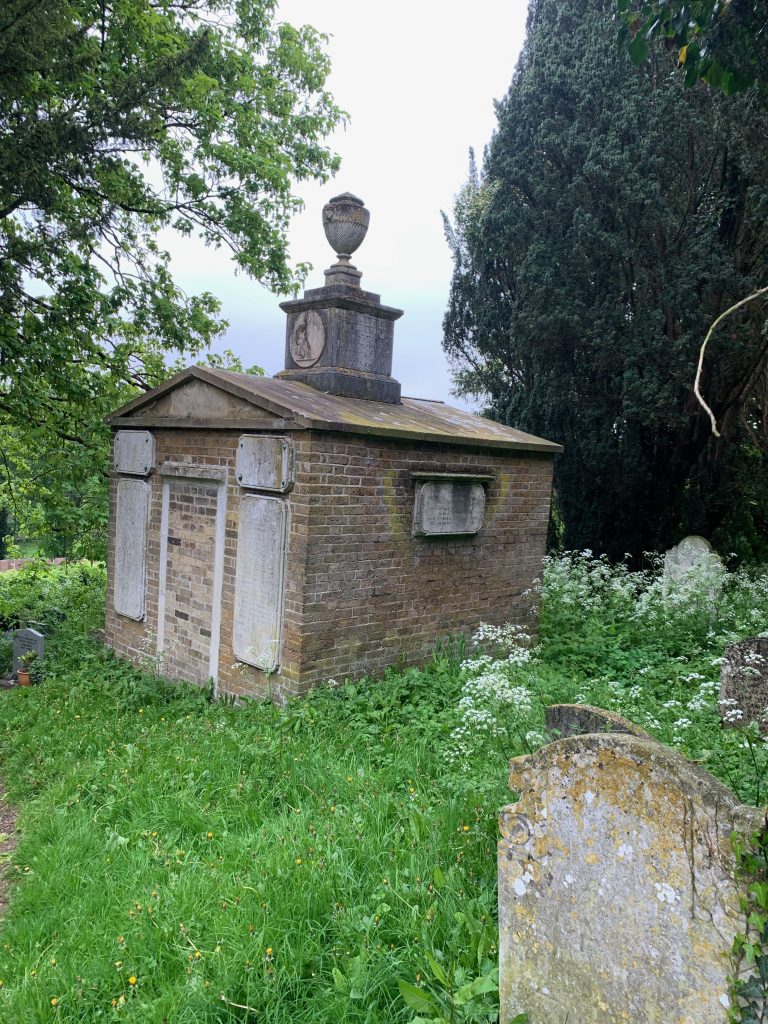
Unexpected hazards, on land and afloat
I’m just reflecting what a delightfully leafy spot this is, when a most unwelcome deposit descends on me from a creature in a tree overhead. So copious is the shit that I wonder what sort of bird could possibly produce all that, or whether it might have been a squirrel? I clean up as best I can with a tissue or two, but spend the rest of the day finding more smears and smudges on my coat and backpack. Pilgrimage certainly has its less romantic moments!
I pass a field full of rabbits and return to the River Lee. As I come into Ware I have to drop to my knees to scramble under the trunk of a willow tree which has fallen across the path. A man on a nearby boat tells me it fell at 4am this morning, narrowly missing his boat and possibly damaging his neighbour’s, which is partly obscured by the branches. It must have been an alarming moment.

Finding saints and getting lost in Ware
Ware is a busy town, where I spend too long wandering up and down the High Street in search of the ideal coffee shop. In the large parish church of Saint Mary, I am thrilled to discover my second pilgrim stamp for my Credencial. There’s a wonderful carved stone font here, dating back to 1380, and I spot Saint Katharine, patron of my schooldays, on one of its eight sides, along with feisty Saint Margaret who killed the dragon who had the temerity to swallow her whole, and Saint James, patron of pilgrims*. Saint Katharine appears again in one of the church’s glorious stained-glass windows, carrying her wheel, and prominent in a purple cloak and golden crown. I have a sense that she’s accompanying me on my pilgrimage.
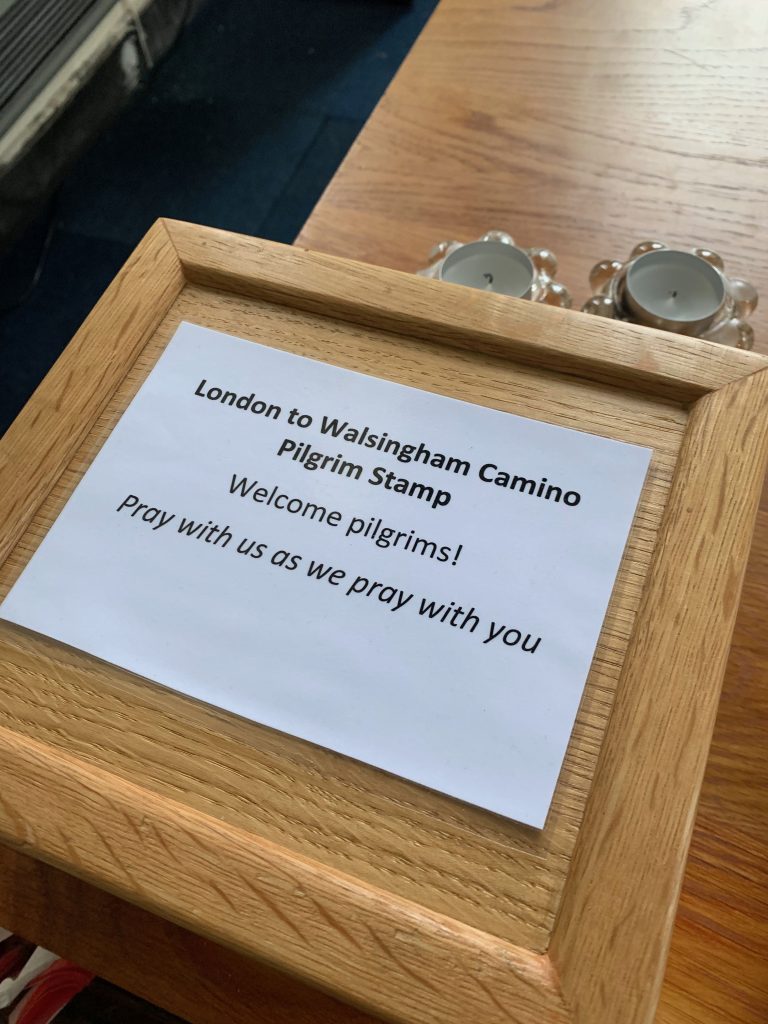

Escape into open countryside
Still, Saint Katharine doesn’t manage to stop me heading out of Ware in the wrong direction, and, by the time I’ve realised my mistake, I’m running late. My sister-in-law, Claire, is going to walk with me this afternoon, and I’ve arranged to meet her in Much Hadham for lunch at 1pm. I need to put some serious speed on. Until now I’ve scarcely had to think about navigation; I’ve just been following the River Lee Navigation north out of London. From Ware onwards that all changes, and I need to pause and check my map and directions frequently.
On the plus side, I finally feel I’ve escaped the urban pull of London as I strike out into open countryside. The route takes me across fields full of pink campion flowers, over a hill, and down into the valley of the pretty River Ash. I follow the track of a former railway, so long disused that the trees meet overhead to form a green tunnel and rabbits have dug their warrens into the crumbling banks. Then I emerge into sloping meadows, where brown Jersey cows graze below terracotta dairy farm buildings in a scene that could come straight out of a children’s picture book. There’s a turreted archway, a dovecote, and an octagonal chapel. These charming Victorian gothic buildings on the Easneye Estate were designed by Alfred Waterhouse, who is more famous for designing the Natural History Museum in London*.
Back on the old railway line, I spot the remnants of a station, no more than heaps of rubble and the edge of a platform almost submerged by trees, and reflect on nature’s power to reclaim. The cow parsley is head-high, mingled with green alkanet with its bright blue flowers, buttercups, and stinging nettles in profusion. A pair of red kites soar and glide gloriously above the river. Wide-winged swifts weave and dive, hunting insects in the air. I recall my junior school teacher, the appropriately named Mr Wood, who used to take us on nature walks every week and teach us to identify birds and wild flowers. I doubt teachers have the time nowadays, with all the pressures of national curriculum and constant testing of pupils, but I’m so grateful I learned to see the natural world as a child. Thank you, Mr Wood, and God bless you, wherever you are today.
I’m still hurrying towards my lunchtime rendezvous, and I make my first (but not last!) decision to skip a small part of the ‘official’ route. Andy Bull’s excellent guidebook* leads the pilgrim on lots of little detours to take in churches and other points of interest along the way, but on this occasion, I decide to bypass the church in Wareside and prioritise my lunch.
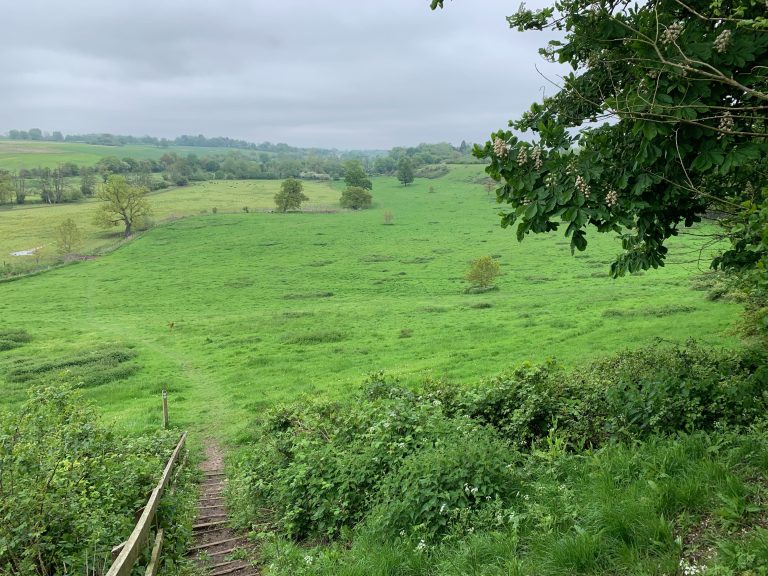
Too posh for sandwiches!
After another stretch of old railway path and a noticeable hill, I reach the next village of Widford, where my path takes me through the churchyard. There’s a stunning view from the back gate behind the church, with steps leading down into a wide, green valley where the River Ash meanders. I spot a group of little egrets at a pool in the middle of the fields. Little egrets are small, pure white herons, and I always feel blessed when I see them. Many traditions endow them with spiritual significance, associating these elegant birds with resourcefulness, calm and purity*. For me, they are a reminder of God’s presence, and I am thankful.
As I stride on into the woods, definitely late for lunch now, Claire messages to ask ask if she should order me something in the pub. I suggest a sandwich or a ploughman’s lunch – something that won’t get cold if I arrive late. The reply comes back that The Bull in Much Hadham doesn’t do sandwiches, only tapas! Clearly too posh for sandwiches, I quip back. The last bluebells are fading in the woods, and the path is extremely muddy after what has been a very rainy spring. I’m glad I wore my hiking boots. The village of Hadham Cross is even wetter underfoot as here a small river runs along the surface of a road for a good couple of hundred metres, pushing the concept of a ‘ford’ to its limits!

Hassocks and toadstones
It’s a relief to reach The Bull only about forty-five minutes later than planned. Claire and her husband are waiting for me, and we tuck into chorizo sausage, deep fried brie, meatballs, and roasted peppers – delicious! Once fed and watered we amble up to the village church of St Andrew and Holy Cross, which is shared by local Anglican and Roman Catholic communities – surely an excellent idea in a rural area where both congregations may be quite small.
Entering the church, we are struck by the display of embroidered kneelers (aka hassocks, to use the proper churchy term), which are all sitting on the tops of the pews instead of being hidden away on the floor. There must be hundreds of hassocks, stitched with a stunning variety of illustrations. As well as Bible stories and characters, we spot local cottages and landscapes, prayers and quotations, saints, and sporting scenes – the whole sphere of village life and faith, sewn onto cushions. Noah’s ark, the Lord’s prayer, golfers, cricket, and the River Ash all find a place here. It’s a perfect embodiment of the idea that prayer should encompass every aspect of life, not just the ‘religious’ bits. How many stitchers were involved, we wonder, and who organised the project? It’s most impressive.
A statue of Our Lady of Walsingham in the church reminds me of the goal of my pilgrimage. Mary is sculpted seated on a wooden throne banded with seven rings of gold. She wears a Saxon crown on her head and holds a triple-flowered lily and the infant Jesus with a book of the Gospels*. This statue is a copy of the modern one in Walsingham, which is itself based on the medieval priory seal. It is thought that the original medieval statue of Our Lady of Walsingham was burned at the time of the Reformation (although there are intriguing rumours that a wooden statue, currently in the Victoria and Albert Museum, known as the Langham Madonna might possibly be the original*).
Many statues of Our Lady show her with a serpent or dragon under her feet to signify the crushing of the serpent’s head by the woman prophesied in Genesis 3:15. The Walsingham statue is unique in that Mary sits above a green toadstone. What is a toadstone? I hear you ask. I wondered that too. Apparently, it’s a symbol of the power of evil, with particular East Anglian associations. Toads were used in witchcraft and magic in medieval times, and a toadstone was a gem believed to be formed in the head of a toad. Mary crushes superstition and idolatry under her feet by her trusting ‘yes’ to God.


Time for tea and cake
Leaving the church, Claire and I set off up a hill, across fields and through open countryside towards the town of Bishop’s Stortford. It’s nice to have someone to talk to after many hours hiking alone, and we take the opportunity to catch up on family news.
The Hertfordshire Way is generally well signposted, but on the outskirts of Bishop’s Stortford we run into navigational trouble in a modern housing estate with a maze of curving cul-de-sacs. It takes several tiresome re-tracings of our steps before we come out onto the wide playing fields of Bishop Stortford College. From here we head towards the tall spire of a church which hopefully marks the town centre.
We go into the Roman Catholic church of the English Martyrs, which has a very beautiful blue vaulted ceiling painted with gold stars. The Anglican church next door is locked up, but I can’t say I’m disappointed. I like a church as much as the next person, but right now what I really need is a cup of tea, ideally accompanied by cake. It’s almost five pm – getting lost slowed us down – and our biggest worry is that we’ve got to the town too late.
This seems to be confirmed when the first teashop we try tells us they’re closing, and we’re half-resigned to another three miles without refreshment, when we come across a delightful Greek cafe and delicatessen called Nostimo. The friendly proprietors lavish us with large pots of tea and big, creamy sugary confections to help us on our way. We feel rather guilty when we realised our boots have left mud all over their floor.
The last stretch of the day takes us past the mound which is all that remains of Bishops Stortford’s castle, alongside the railway line, and through the valley of the River Stort. Meadows, reedbeds and woodland make it a green and pleasant walk, although in places we have to squeeze between tall nettles. It’s a good thing I wore long trousers, and not shorts, today. We cross the county border from Hertfordshire into Essex before a final tramp through woodlands into the little town of Stansted Mountfitchet.
I am more than ready to finish here. I forgot the charging cable for my Garmin watch this weekend, so I’m not sure how far I’ve walked today, but my feet and hips are saying at least twenty miles, maybe more. Claire is being picked up by her husband here, so I say my goodbyes, and quickly find my accommodation for the night: a charming cottage close to the centre of town.
My host recommends the local Chinese takeaway for my dinner and seems a little bemused when I ask if they deliver, as it’s only a hundred metres or so away. Summoning my inner hunter-gatherer, I head out to get sweet-and-sour chicken and rice. Almost as soon as I’ve eaten, I’m on my weary way to bed. It’s been a good day, but a long one, and the sun never did manage to break through the clouds. Tomorrow I head onwards through the north-west corner of Essex. Perhaps the sun will come out tomorrow!
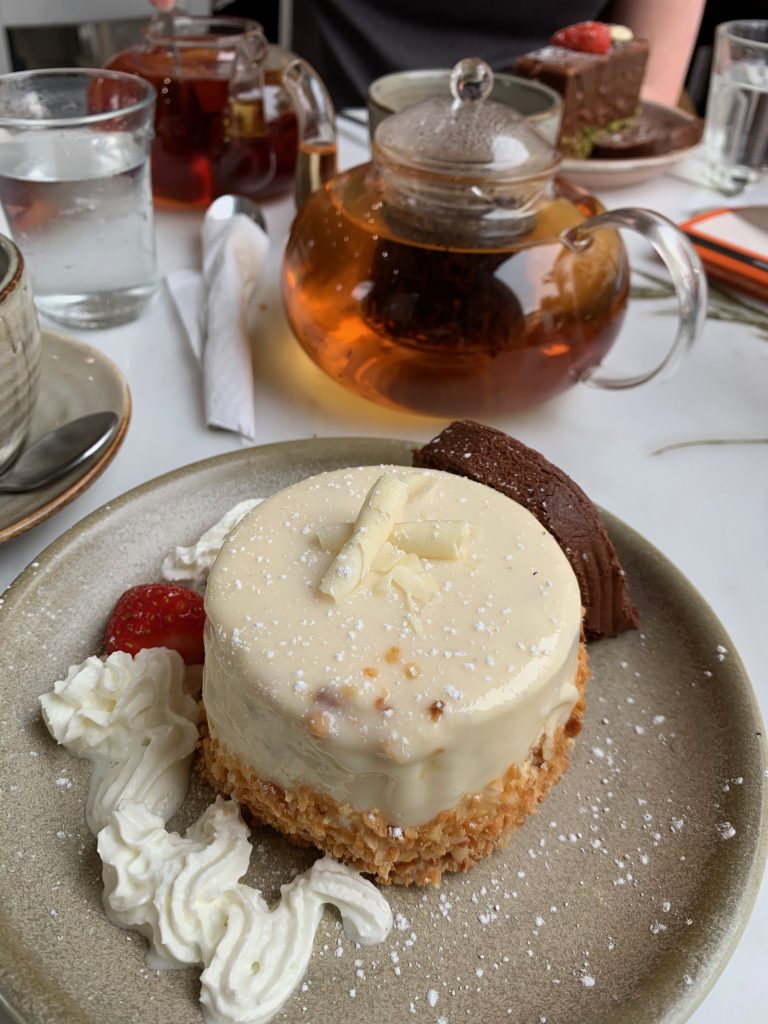
Karen Lawrence is a mother, grandmother, yoga teacher and writer. She lives with husband Adrian and youngest daughter Martha in Billericay, Essex, United Kingdom. Karen has published two books and is currently working on a novel about outlaw midwives in a dystopian future Britain.
Letting the Light In: How A Baby With Down Syndrome Changed My Life is Karen’s personal account of having a baby with Down Syndrome. It is available from Amazon at
Karen’s first book, Finding Your Calm Space: Thirty-One Ways to find Calm in a Crazy World is available from Amazon at
If you would like to follow Karen and be kept up to date with her writing, please sign up at https://karenlawrenceauthor.com/join-the-mailing-list/
Further Reading
You can read more here about No Mow May https://www.plantlife.org.uk/campaigns/nomowmay/#
More information about Great Amwell church and the Mylne family at these websites:
https://hertfordshirechurches.weebly.com/great-amwell-church-hertfordshire.html
https://www.salhs.org.uk/folders/Pool/Pool.pdf
https://en.wikipedia.org/wiki/Robert_Mylne_(architect)
You can learn more here about the wonderful medieval font in Ware church http://www.icknieldindagations.com/2015/09/saints-and-angels-font-in-ware-herts.html
More here about Alfred Waterhouse and the Easneye Estate
Fascinating information about the symbolism of egrets:
https://www.richardalois.com/symbolism/egret-symbolism
Iconography and history of the image of Our Lady of Walsingham: https://www.walsingham.org.uk/the-statue-of-our-lady-of-walsingham/
https://www.jlewisstatues.co.uk/post/symbolism-of-our-lady-of-walsingham




